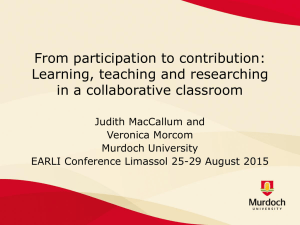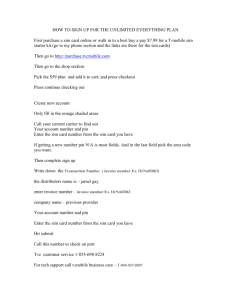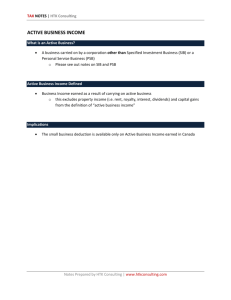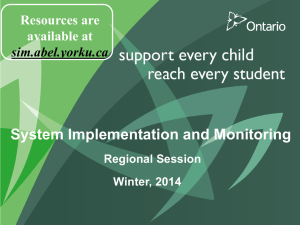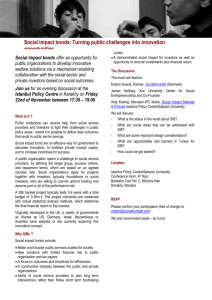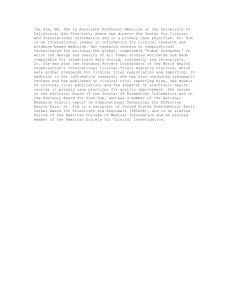Document
advertisement
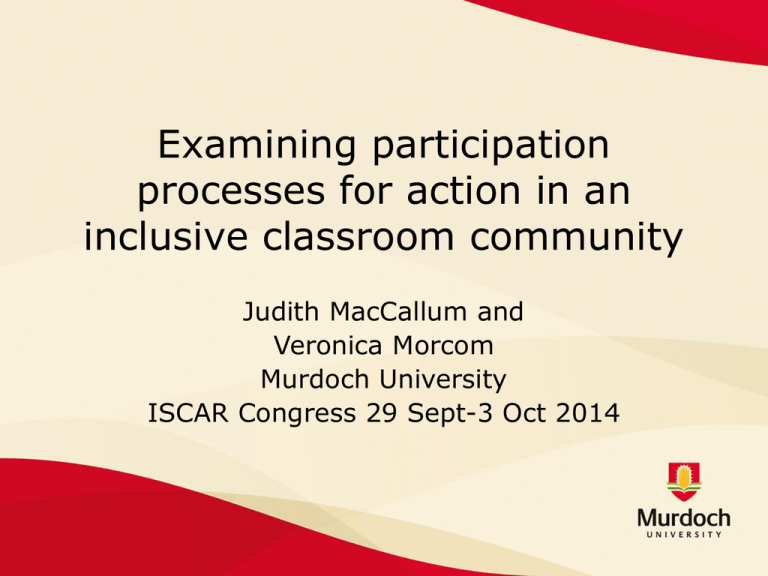
Examining participation processes for action in an inclusive classroom community Judith MacCallum and Veronica Morcom Murdoch University ISCAR Congress 29 Sept-3 Oct 2014 Overview • Context of the study – year 3 classroom • Sociocultural perspective • Classroom participation research • Brief methodology and data sources • Participation and communication patterns over a school year • What next? Research context - Year 3 classroom • Democratic classroom with students participating in decisions for action, with direction offered by cultural and social values • Teacher’s practice not privileged in the school • School is situated in middle class urban area • Social practices included • class agreements • daily social circle • weekly class meetings • Tribes with child selected leaders and vice leaders Daily social circle Sociocultural perspective • The learner is constituted by cultural and historical processes, embedded within cultural activities in communities which provide the tools for making sense of the world • It is usually understood that these tools are appropriated in social interactions, providing the means to maintain and transform those communities (Rogoff, 2003) • Used Rogoff’s planes for analysis – institutional/community, interpersonal, personal – this paper foregrounds interpersonal Aim of this study • To examine student participatory roles in class meetings over a school year • To examine communicative support provided by the teacher in class meetings to support student participatory roles Participation in communities • Legitimate peripheral participation to mature participation – individuals (Lave & Wenger, 1991; Rogoff, 2003) • Social construction of participatory roles in primary school classroom (Kovalainen & Kumpulainen, 2007) – identified different and relatively stable modes of student participation with differing teacher participation • • • • Vocal participants Responsive participants Bilateral participants Silent participants Different participatory roles Based on •Amount of participation – number of coded interaction pieces •Discourse moves – initiating responding, follow-up, responding •Interaction sequences – SIM, SIM/T, TIM, TIB •Communicative functions – EVI, INFO, VIEW, EVA, CON, ORC, DEF, NEU •Nature of teacher participation – providing structural support, analytic support, social support, encouraging Communication and interaction patterns (Kovalainen & Kumpulainen, 2007) Interaction sequences (8) – e.g. teacher TI or student initiated SI, bilateral TIB/SIB or multilateral TIM/SIM, with (SIM/T) or without teacher participation Communicative functions (10) –e.g. asking for and providing evidence, reasons (EVI); asking for and sharing experiences, feelings (EXP); orchestrating the discussion (ORC); elaborations (DEF); views, opinions, perspectives (VIEW); confirm, acknowledge (CON); non-verbal (N-VERB); evaluate, correct (EVA) Range of participatory opportunities • Social circle – student solo initiation SI • Class meeting – TIM, TIB, SIM/T, SIB/T, SIM, SIB • Tribes leader and Vice leader – SIM, SIB • Tribes members – SIM, SIB • Philosophy lesson – TIM, TIB, SIM/T, SIB/T, SIM, SIB • Think Pair Share – SIB, SIB/T Method and data sources • Year long ethnographic study in Year 3 classroom with teacher/researcher and 24/25 students aged 9 • Researcher spent about 1 day per week in the classroom • Multiple data sources, including observation, videoing class meetings and other activities, reflection logs (teacher/researcher, researcher, students), sociometric surveys, interviews with students and parents (with photo stimulated recall) Data for this analysis • Video of class meetings over the school year (23) – approximately 30 minutes each. Students could ‘put up’ an item they wished class to discuss • Analysis for this paper of three class meetings – beginning term 1, early term 3 and end term 4 • Teacher reflections & researcher field notes • Students’ views of class meetings Number of student items over year Mean No. of Student Items per Class Meeting 4.5 4 3.5 3 2.5 Individual 2 Pair 1.5 1 0.5 0 Term 1 Term 2 Term 3 School Term over Year Term 4 Number of students with item 20 Number of Students involved 18 16 14 12 10 Number of students 8 6 4 2 0 Term 1 Term 2 Term 3 School Terms over Years Term 4 First class meeting Communication patterns • Class meeting 1, first week of term 1, 2/02/2007 • Three teacher items – addressed first, with teacher encouraging participation from class and individuals - TIM, TIB sequences • Three student items – in order of placement on the whiteboard. These three students participated as vocal participants SIB/T, SIM/T • Other students participated in mainly bilateral interactions initiated by the three students or the teacher • Teacher provides structural, analytic, social support Teacher Item TIM Teacher Initiated sequence at beginning to all Ss TI First of all I want to talk about instructions [Talks about something that happened at end of previous day] INFO EXP INFO TF What do you think that means for your desk? VIEW SR [Hands go up] N-VERB SIB/T Student Initiated sequence with T S1I [Hand up ready to provide explanation] N-VERB TR What do you think S1? VIEW S1R [explains ] INFO TF Mm CON First student item TF: Where’s S2? S2: [moves to front of class] ORC N-VERB TIB TI: S2 you put down a really important item EVA S2, I want you to explain to the class what this means to you EVI TIM TI: I want you to listen very carefully because you might have some really good ideas too SIM/T S2: [explains to class] ACT EVI INFO EVI S2: [looks to teacher] N-VERB TR: [nods] N-VERB S2: [continues speaking] TR: That sounds like a really good idea, S2 EXP INFO EVA TF: Does anyone have any questions that they would like to ask S2? VIEW S2: [points to S3] ORC S3: [asks more about S2’s experience] EXP TF: What kind of activities are they S2? DEF Class meeting 17 Class meeting 17, 10/08/2007 • Three teacher items. Four student items (2 individual, 2 pairs) • Students voted as to which items would be discussed first • Teacher wrote down discussion points on another board • SIM, SIB and SIM/T sequences • Students’ communicative functions recounts of experience and feelings (EXP), observations (INFO), views and opinions (VIEW), reasons for view (EVI) • Teacher’s communication functions predominately orchestrating (ORC) and acknowledging (CON), later asked ‘are these stories or solutions?’ (INFO?) - structuring and social support, meta work? Last class meeting Class meeting 23 6/12/2007 • There were no teacher items and five student items (3 individual, 2 pairs) • Teacher asks if anyone wants to take teacher role – almost all hands go up, and negotiation with class as to how to decide. Several students without an item on board took turns as Teacher. None were initially Vocal participants • Teacher takes a position at the blackboard out of mat area, but intervenes to remind students to be respectful then, ‘Let’s try again’ (ORC) – mainly social support and meta? • SIM and SIB sequences. Student T support participation (ORC) and provide ideas (INFO), rather than to ask for ideas (INFO) opinions (VIEW) • Some multilateral sequences between students using ‘agree’ and ‘disagree’ phrases from philosophy lessons, e.g. ‘I do agree about …., but I don’t agree because …’ Students’ perspectives • Talking about things that we need to do more or get better at … sometimes gets a bit boring • We can discuss things • …help people change what’s happening at lunchtime and in our classroom • We can agree and disagree • … to listen to people, sort of like a sit down. ..[learn to be] nice and respectful • when we have problems, to sort out our problems, class goals, people not feeling good, put them up • I like the debating, even if we don’t win • I don't like discussing • Back gets sore sitting down on the mat that long Conclusions • Over the year the classroom practices provided opportunities for students to develop different participatory roles. Class meetings provided opportunity for students to initiate multilateral sequences • Class meetings provided the teacher with the opportunity to model a range of communicative functions (asking for, and sharing), nature of support changed over year, included meta work • Students mainly orchestrated discussion (ORC), shared ideas (INFO), opinions (VIEW), feelings and experiences (EXP), offered evidence (EVI) or clarification (DEF) and evaluated feedback (EVA). A smaller number of students asked for other students’ opinions and experiences • Needed ACT for request action, WAIT for silence, waiting – meta level? • Items with student pairs offered opportunity for a different range of participatory roles What next? • Review coding and consider meta level of teacher support • Examine wider classroom practices – e.g. Tribes and Leader and Vice Leader sequences for communicative functions - do students ask for ideas and opinions in the smaller group? Relation to class meeting roles? • Examine changes in participatory roles of initially Silent, Responsive and Bilateral participants Thank you Comments? Questions? jamac@murdoch.edu.au
